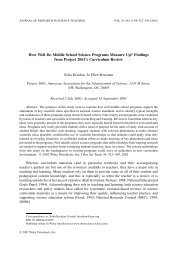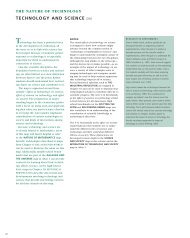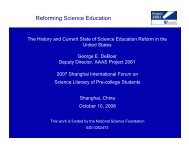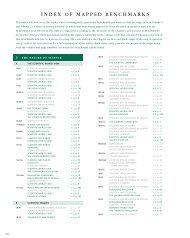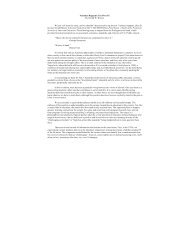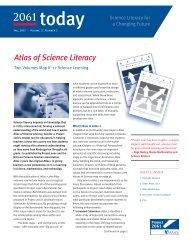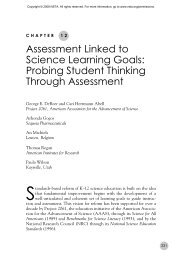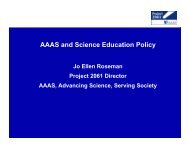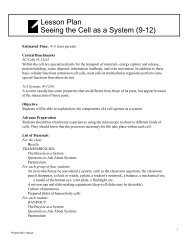Integrating the History and Nature of Science and ... - Project 2061
Integrating the History and Nature of Science and ... - Project 2061
Integrating the History and Nature of Science and ... - Project 2061
Create successful ePaper yourself
Turn your PDF publications into a flip-book with our unique Google optimized e-Paper software.
<strong>Integrating</strong> <strong>the</strong> <strong>History</strong> <strong>and</strong><br />
<strong>Nature</strong> <strong>of</strong> <strong>Science</strong> <strong>and</strong><br />
Technology in <strong>Science</strong> <strong>and</strong> Social<br />
Studies Curriculum<br />
RODGER W. BYBEE, JANET C. POWELL, <strong>and</strong><br />
JAMES D. ELLIS<br />
Biological <strong>Science</strong>s Curriculum Study (BSCS), 830 North Tejon, Suite 405,<br />
Colorado Springs, CO 80903<br />
JAMES R. GIESE, LYNN PARISI, <strong>and</strong> LAUREL SINGLETON<br />
Social <strong>Science</strong> Education Consortium (SSEC), 3300 Mitchell Lane, Suite 240,<br />
Boulder, CO 80301<br />
The Importance <strong>of</strong> Underst<strong>and</strong>ing The <strong>History</strong> <strong>and</strong> <strong>Nature</strong> <strong>of</strong><br />
<strong>Science</strong> <strong>and</strong> Technology<br />
The decade <strong>of</strong> <strong>the</strong> 1980s was a period <strong>of</strong> pressure for <strong>and</strong> movement towards<br />
educational reform. During <strong>the</strong> early 1980s, numerous reports focused attention on <strong>the</strong><br />
failure <strong>of</strong> education in general, <strong>and</strong> science <strong>and</strong> ma<strong>the</strong>matics education in particular, to<br />
prepare American students for <strong>the</strong> 21st century. These efforts, in turn, influenced calls for<br />
reform in <strong>the</strong> fields <strong>of</strong> science <strong>and</strong> social studies education. Several trends have particular<br />
relevance for <strong>the</strong> teaching <strong>of</strong> <strong>the</strong> history <strong>and</strong> nature <strong>of</strong> science <strong>and</strong> technology. First, <strong>the</strong>re<br />
is a push for <strong>the</strong> general improvement <strong>of</strong> scientific literacy. Second, <strong>the</strong>re is a resurgence<br />
<strong>of</strong> interest in history instruction. And third, <strong>the</strong> trend toward <strong>the</strong> integration <strong>of</strong> sciencetechnology-society<br />
<strong>the</strong>mes into contemporary school programs. Authors such as Bertr<strong>and</strong><br />
Russell <strong>and</strong> C. P. Snow addressed <strong>the</strong> importance <strong>of</strong> underst<strong>and</strong>ing science <strong>and</strong> society<br />
connections in <strong>the</strong>ir books The Impact <strong>of</strong> <strong>Science</strong> on Society (Russell, 1951) <strong>and</strong> The Two<br />
Cultures (Snow, 1962). These insights, however, had little influence on school programs.<br />
The situation in which individuals nei<strong>the</strong>r perceive nor underst<strong>and</strong> connections between<br />
science <strong>and</strong> society is partially due to <strong>the</strong> fact that we do not teach about those<br />
connections. Presenting students with <strong>the</strong> historical influences <strong>of</strong> science on society <strong>and</strong><br />
society on science could help fulfill <strong>the</strong> goal <strong>of</strong> citizenship.<br />
<strong>Science</strong> Education 75(1): 143 -155 (1991)<br />
© 1991 John Wiley & Sons, Inc. CCC 0036-8326/91/010143—13$04.00
144 BYBEE ET AL.<br />
In Educating Americans for <strong>the</strong> 21st Century, <strong>the</strong> National <strong>Science</strong> Board summerizes<br />
<strong>the</strong> reasons for this emphasis on science <strong>and</strong> technology in a social context.<br />
<strong>Science</strong> <strong>and</strong> technology are integral parts <strong>of</strong> today’s world. Technology, which grows<br />
out <strong>of</strong> scientific discovery, has changed <strong>and</strong> will continue to change our society.<br />
Utilization <strong>of</strong> science in <strong>the</strong> solution <strong>of</strong> practical problems has resulted in complex<br />
social issues that must be intelligently addressed by all citizens. Students must be<br />
prepared to underst<strong>and</strong> technological innovation, <strong>the</strong> productivity <strong>of</strong> technology, <strong>the</strong><br />
impact <strong>of</strong> <strong>the</strong> products <strong>of</strong> technology on <strong>the</strong> quality <strong>of</strong> life, <strong>and</strong> <strong>the</strong> need for critical<br />
evolution <strong>of</strong> societal matters involving <strong>the</strong> consequences <strong>of</strong> technology (NSB, 1983,<br />
p. 44).<br />
This quotation highlights <strong>the</strong> need for students to underst<strong>and</strong> <strong>the</strong> nature <strong>of</strong> both science<br />
<strong>and</strong> technology; it especially emphasizes technology. The term “scientific <strong>and</strong><br />
technological literacy” express <strong>the</strong> goal <strong>of</strong> underst<strong>and</strong>ing science <strong>and</strong> technology.<br />
The National <strong>Science</strong> Teachers Association (NSTA) position statement “<strong>Science</strong>-<br />
Technology-Society: <strong>Science</strong> Education for <strong>the</strong> 1980s” describes several attributes <strong>of</strong><br />
scientific <strong>and</strong> technologic literacy. According to NSTA, students should be able to<br />
• Underst<strong>and</strong> how society influences science <strong>and</strong> technology, as well as how science<br />
<strong>and</strong> technology influence society.<br />
• Underst<strong>and</strong> that <strong>the</strong> generation <strong>of</strong> scientific knowledge depends upon <strong>the</strong> inquiry<br />
process <strong>and</strong> upon conceptual <strong>the</strong>ories.<br />
• Recognize <strong>the</strong> origin <strong>of</strong> science <strong>and</strong> underst<strong>and</strong> that scientific knowledge is<br />
tentative, <strong>and</strong> subject to change as evidence accumulates. (NSTA, 1982, p. 1).<br />
Many science educators agree that technologically <strong>and</strong> scientifically literate people<br />
must underst<strong>and</strong> something <strong>of</strong> <strong>the</strong> history <strong>and</strong> nature <strong>of</strong> science <strong>and</strong> technology<br />
(Showalter, 1974; Duschl, 1985; Bybee, 1986; Hurd, 1987; Garrison & Bentley, 1990).<br />
<strong>Project</strong> <strong>2061</strong>, an effort by education in science, technology, <strong>and</strong> ma<strong>the</strong>matics, believes<br />
that such knowledge is critical to not only scientific <strong>and</strong> technologic literacy, but cultural<br />
literacy as well. The following about coverage <strong>of</strong> <strong>the</strong> history <strong>of</strong> science <strong>and</strong> technology in<br />
American schools is from <strong>Science</strong> for all Americans (AAAS, 1989).<br />
There are two principal reasons for including some knowledge <strong>of</strong> history among <strong>the</strong><br />
recommendations. One reason is that generalizations about how <strong>the</strong> scientific enterprise<br />
operates would be empty without concrete examples. Consider, for example, <strong>the</strong><br />
proposition that new ideas are limited by <strong>the</strong> context in which <strong>the</strong>y are conceived; are<br />
<strong>of</strong>ten rejected by <strong>the</strong> scientific establishment; sometimes spring from unexpected<br />
findings; <strong>and</strong> usually grow slowly, through contributions from many different<br />
investigators. Without historical examples, <strong>the</strong>se generalizations would be no more than<br />
slogans . . . A second reason is that some episodes in <strong>the</strong> history <strong>of</strong> <strong>the</strong> scientific endeavor<br />
are <strong>of</strong> surpassing significance to our cultural heritage. Such episodes certainly include<br />
Galileo’s role in changing our perception <strong>of</strong> our place in <strong>the</strong> universe; Newton’s<br />
demonstration that <strong>the</strong> same laws apply to motion in <strong>the</strong> heavens <strong>and</strong> on earth; Darwin’s<br />
long observations <strong>of</strong> <strong>the</strong> variety <strong>and</strong> relatedness <strong>of</strong> life forms that led to his postulating a<br />
mechanism for how <strong>the</strong>y came about; Lyell’s identification <strong>of</strong> infectious disease with tiny<br />
organisms that could be seen only with a microscope. These stories st<strong>and</strong> among <strong>the</strong><br />
milestones <strong>of</strong> <strong>the</strong> development <strong>of</strong> all thought in western civilization (AAAS, 1989,<br />
p.111).
TEACHING HISTORY: A RATIONALE 145<br />
Hickman, Patrick, <strong>and</strong> Bybee provide fur<strong>the</strong>r support for <strong>the</strong> notion that underst<strong>and</strong>ing<br />
<strong>the</strong> nature <strong>and</strong> history <strong>of</strong> science <strong>and</strong> technology is an element <strong>of</strong> cultural literacy. They<br />
assert that “some fundamental connections between science, technology, <strong>and</strong> society were<br />
established in <strong>the</strong> canons for scientific investigation <strong>and</strong> definition <strong>of</strong> <strong>the</strong> American social<br />
order,” making science <strong>and</strong> technology “a conceptual heritage in <strong>the</strong> historical documents<br />
out <strong>of</strong> which this country was born <strong>and</strong> which continue to influence our social<br />
development” (Hickman, Patrick, & Bybee, 1987, pp. 2-3). Such a view would<br />
undoubtedly be supported by <strong>the</strong> advocates <strong>of</strong> a stronger educational emphasis on history<br />
<strong>and</strong> philosophy (Adler, 1982; Ravitch & Finn, 1987; Bloom, 1987; Hirsch, 1987; Cheney,<br />
1987).<br />
Social studies educators view teaching about <strong>the</strong> history <strong>and</strong> nature <strong>of</strong> science <strong>and</strong><br />
technology through ano<strong>the</strong>r lens—<strong>the</strong> need for students to become competent decision<br />
makers in <strong>the</strong> personal <strong>and</strong> civic arenas (Bragaw & Hartoonian, 1988). Today’s citizens<br />
are not only affected by science-based developments, <strong>the</strong>y are increasingly called upon,<br />
through <strong>the</strong>ir participation in <strong>the</strong> democratic political process, to affect public policy<br />
concerning <strong>the</strong> development <strong>and</strong> application <strong>of</strong> science <strong>and</strong> technology.<br />
Given this situation, it is important for people to underst<strong>and</strong> science as a key element<br />
in intellectual history—<strong>the</strong> achievements <strong>of</strong> <strong>the</strong> human mind (Ronan, 1982). Fur<strong>the</strong>rmore,<br />
studying <strong>the</strong> history <strong>of</strong> science <strong>and</strong> technology will help young citizens recognize factors<br />
influencing innovation <strong>and</strong> act accordingly when confronting <strong>the</strong>m (Burke, 1978).<br />
Similarly, some knowledge <strong>of</strong> <strong>the</strong> history <strong>of</strong> technology is necessary to avoid <strong>the</strong> pitfalls<br />
<strong>of</strong> policies shaped by “technological utopianism—<strong>the</strong> hope <strong>of</strong> a better tomorrow through<br />
purely technological solutions” (Corn, 1986). Melvin Kranzberg has summarized <strong>the</strong><br />
importance <strong>of</strong> this subject for developing rational decision making as follows<br />
Clearly we are living in a scientific <strong>and</strong> technological age. Well, <strong>the</strong>n, how did it get<br />
to be that way? If we could learn how it got to be that way, we might possibly be<br />
able to deal effectively with problems caused by <strong>the</strong> advance <strong>of</strong> science <strong>and</strong><br />
technology <strong>and</strong>, conversely, to deal with problems that science <strong>and</strong> technology might<br />
help resolve (quoted in Post, 1989, p. 36).<br />
A 1980 report by The Commission on <strong>the</strong> Humanities included this statement in The<br />
Humanities in American Life.<br />
The humanities are an important measure <strong>of</strong> <strong>the</strong> values <strong>and</strong> aspirations <strong>of</strong> any<br />
society. Intensity <strong>and</strong> breadth in <strong>the</strong> perception <strong>of</strong> life <strong>and</strong> power <strong>and</strong> richness in<br />
works <strong>of</strong> <strong>the</strong> imagination betoken a people alive as moral <strong>and</strong> aes<strong>the</strong>tic beings,<br />
citizens in <strong>the</strong> fullest sense. They can use <strong>the</strong>ir scientific <strong>and</strong> technical achievements<br />
responsibly because <strong>the</strong>y see <strong>the</strong> connections among science, technology, <strong>and</strong><br />
humanity (p. 3).<br />
The Commission on <strong>the</strong> Humanities made an explicit connection between instruction in<br />
<strong>the</strong> humanities <strong>and</strong> science <strong>and</strong> technology. The report emphasizes <strong>the</strong> creative<br />
connections between science, technology, <strong>and</strong> <strong>the</strong> humanities <strong>and</strong> highlights <strong>the</strong> historical<br />
context <strong>of</strong> <strong>the</strong>se connections<br />
Scientific models can sharpen <strong>and</strong> give insights into <strong>the</strong> characteristics <strong>of</strong><br />
information… .Social <strong>and</strong> ethical questions are intrinsic to science <strong>and</strong> technology. In<br />
<strong>the</strong>se respects, science <strong>and</strong> technology have been a domain <strong>of</strong> <strong>the</strong> humanities in
146 BYBEE ET AL.<br />
Western culture since its Greek origins. . . . This Commission needs not to elaborate<br />
<strong>the</strong> fact that throughout history science <strong>and</strong> technology have had enormous impact on<br />
<strong>the</strong> way people work, live, <strong>and</strong> die (pp. 14, 16).<br />
The Commission concludes its discussion with <strong>the</strong> recommendation that<br />
Courses in humanities should probe connections between <strong>the</strong> humanities <strong>and</strong> o<strong>the</strong>r<br />
fields <strong>of</strong> knowledge. For example, humanistic questions are inherent in—<strong>and</strong> should<br />
foster an awareness <strong>of</strong>—<strong>the</strong> moral dimensions <strong>of</strong> science <strong>and</strong> technology. Teachers<br />
<strong>and</strong> students should consider <strong>the</strong> human purposes <strong>of</strong> scientific discovery <strong>and</strong><br />
scientific invention.<br />
A 1988 report prepared by <strong>the</strong> Bradley Commission on <strong>History</strong> in Schools, Building A<br />
<strong>History</strong> Curriculum: Guidelines for Teaching <strong>History</strong> in Schools, gave some recognition<br />
<strong>of</strong> <strong>the</strong> importance <strong>of</strong> science <strong>and</strong> technology in a list <strong>of</strong> vital <strong>the</strong>mes <strong>and</strong> narratives. One<br />
<strong>of</strong> six <strong>the</strong>mes was human interaction with <strong>the</strong> environment. That <strong>the</strong>me was described as<br />
The relationships among geography, technology, <strong>and</strong> <strong>the</strong>ir effects on economic,<br />
social, <strong>and</strong> political developments. The choices made possible by climates, resources,<br />
<strong>and</strong> location, <strong>and</strong> <strong>the</strong> effect <strong>of</strong> culture <strong>and</strong> human values on such choices. The gains<br />
<strong>and</strong> losses <strong>of</strong> technological change. The central role <strong>of</strong> agriculture. The effects <strong>of</strong><br />
disease, <strong>and</strong> disease fighting on plants, animals, <strong>and</strong> human beings (p.<br />
10).<br />
Note <strong>the</strong> clear emphasis on science <strong>and</strong> technology-related social issues. While this<br />
emphasis is commendable, <strong>the</strong>re is still a need for recognizing <strong>the</strong> importance <strong>of</strong> science<br />
<strong>and</strong> technology as human endeavors that influence, <strong>and</strong> are influenced by culture.<br />
Given that underst<strong>and</strong>ing <strong>the</strong> history <strong>and</strong> nature <strong>of</strong> science <strong>and</strong> technology is widely<br />
regarded as contributing to scientific <strong>and</strong> technological literacy, to cultural literacy, <strong>and</strong> to<br />
<strong>the</strong> ability to make reasoned decisions, one would think that science <strong>and</strong> social studies<br />
curricula would have numerous descriptions <strong>of</strong> <strong>the</strong> development <strong>of</strong> major ideas from<br />
science <strong>and</strong> clarifying examples <strong>of</strong> <strong>the</strong> contributions <strong>of</strong> science <strong>and</strong> technology to society.<br />
Such is not <strong>the</strong> case, however, as we point out in <strong>the</strong> next section.<br />
<strong>History</strong> <strong>and</strong> <strong>Nature</strong> <strong>of</strong> <strong>Science</strong> <strong>and</strong> Technology in <strong>the</strong> Current<br />
Curriculum<br />
Research related to <strong>the</strong> status <strong>of</strong> <strong>the</strong> history <strong>and</strong> nature <strong>of</strong> science <strong>and</strong> technology in <strong>the</strong><br />
curriculum indicates that few materials <strong>and</strong> little time are devoted to helping students<br />
develop an underst<strong>and</strong>ing <strong>of</strong> or appreciation for <strong>the</strong> history <strong>and</strong> nature <strong>of</strong> science <strong>and</strong><br />
technology (Harms & Yager, 1981). Four specific areas can be examined for evidence<br />
regarding this issue: student <strong>and</strong> teacher underst<strong>and</strong>ing <strong>of</strong> <strong>the</strong> subject, curriculum<br />
guidelines, studies <strong>of</strong> actual classroom practice, <strong>and</strong> current instructional materials.<br />
Student <strong>and</strong> Teacher Underst<strong>and</strong>ing<br />
Researchers have documented <strong>the</strong> inadequate underst<strong>and</strong>ing <strong>of</strong> science <strong>and</strong> technology by<br />
both students <strong>and</strong> teachers (Mead & Metrauz, 1957; Cooley & Klopfer, 1963; Carey &<br />
Strauss, 1968; Lavach, 1969; Carey & Strauss, 1970; Mackey, 1971; Billeh & Hasan,<br />
1975; Bady, 1979; Rubba et al., 1981; Patrick & Remby, 1984; Lederman O’Malley,<br />
1990). Very importantly, Lederman (1989) has confirmed <strong>the</strong> effect <strong>of</strong> teachers’ language
Teaching <strong>History</strong>: A Rationale 147<br />
on students’ conception <strong>of</strong> <strong>the</strong> nature <strong>of</strong> science. Equally important, some studies (Patrick<br />
& Remy, 1984) showed that students feel a lack <strong>of</strong> control over public issues related to<br />
science <strong>and</strong> technology.<br />
Few studies have been conducted on <strong>the</strong> history <strong>and</strong> nature <strong>of</strong> science. One notable<br />
study (Lederman, 1986) found a slightly higher level <strong>of</strong> underst<strong>and</strong>ing than <strong>the</strong> articles<br />
cited above. Ravitch <strong>and</strong> Finn’s (1987) recent assessment <strong>of</strong> 17-year-old students’<br />
knowledge <strong>of</strong> history contained 16 clusters (subscales), one <strong>of</strong> which was a 10 item<br />
cluster on <strong>the</strong> history <strong>of</strong> science <strong>and</strong> technology. Interestingly, this was one <strong>of</strong> only two<br />
clusters on which students had a mean score <strong>of</strong> more than 70% (71.3%). This finding may<br />
not mean that underst<strong>and</strong>ing <strong>of</strong> <strong>the</strong> history <strong>of</strong> science <strong>and</strong> technology is adequate,<br />
however, since Ravitch <strong>and</strong> Finn’s questions asked generally for recall <strong>of</strong> factual<br />
information ra<strong>the</strong>r than any underst<strong>and</strong>ing <strong>of</strong> <strong>the</strong> complexity <strong>of</strong> <strong>the</strong> creative enterprise, <strong>the</strong><br />
interconnectedness <strong>of</strong> developments in science <strong>and</strong> technology, <strong>and</strong> <strong>the</strong> causes or effects<br />
<strong>of</strong> particular developments.<br />
Curriculum Guidelines<br />
A review <strong>of</strong> 27 state curriculum guidelines in science indicated that slightly less than<br />
half <strong>of</strong> <strong>the</strong> guides called for <strong>the</strong> study <strong>of</strong> <strong>the</strong> history <strong>of</strong> science <strong>and</strong> technology.<br />
Examination <strong>of</strong> state <strong>and</strong> local social studies curriculum guides show little emphasis on<br />
<strong>the</strong> history <strong>of</strong> science <strong>and</strong> technology.<br />
In <strong>the</strong> new <strong>History</strong>-Social <strong>Science</strong> Framework for California Public Schools (1988),<br />
which many observers expect to have a significant impact on social studies nationwide,<br />
<strong>the</strong> importance <strong>of</strong> intellectual history, <strong>of</strong>ten neglected in school history courses, is<br />
stressed. <strong>Science</strong> <strong>and</strong> technology are listed as two aspects <strong>of</strong> culture to be studied in<br />
historical perspective. The course descriptions provided in this document give little<br />
specific attention to <strong>the</strong> history <strong>of</strong> science <strong>and</strong> technology, however.<br />
There is also a new <strong>Science</strong> Framework for California Public Schools (1990). Compared<br />
to earlier <strong>Science</strong> Frameworks, <strong>the</strong> 1990 <strong>Science</strong> Framework has several significant<br />
changes including an emphasis on <strong>the</strong> nature <strong>of</strong> science. Although <strong>the</strong> history <strong>of</strong> science<br />
<strong>and</strong> <strong>the</strong> nature <strong>and</strong> history <strong>of</strong> technology are not prominent, science-technology-society is<br />
clearly a prominent <strong>the</strong>me. Both <strong>the</strong> <strong>History</strong>-Social <strong>Science</strong> Framework (1988), <strong>and</strong> <strong>the</strong><br />
<strong>Science</strong> Framework (1990), <strong>of</strong>fer potential for incorporating information on <strong>the</strong> history <strong>of</strong><br />
science <strong>and</strong> technology into <strong>the</strong> curriculum, <strong>the</strong>y fall short by providing little guidance<br />
about <strong>the</strong> content <strong>and</strong> pedagogy for incorporating <strong>the</strong> history <strong>of</strong> science <strong>and</strong> technology.<br />
Classroom Practice<br />
Empirical research on classroom practice, though sparse, reveals a pattern <strong>of</strong><br />
underemphasis on <strong>the</strong> history <strong>and</strong> nature <strong>of</strong> science <strong>and</strong> technology. For example, a study<br />
by Mitman <strong>and</strong> o<strong>the</strong>rs (1987) showed that seventh-grade life science teachers spent<br />
minimal time addressing material pertinent to <strong>the</strong> history <strong>and</strong> nature <strong>of</strong> science. The<br />
authors’ analysis <strong>of</strong> students’ academic assignments showed a similar underemphasis.<br />
Likewise, in a three-year ethnography <strong>of</strong> six high schools, Guthrie <strong>and</strong> Leventhal (n.d.)<br />
found that teachers gave primary attention to facts, methods, <strong>and</strong> attitudes. Components<br />
<strong>of</strong> science literacy, such as history <strong>and</strong> philosophy, were not an integral part <strong>of</strong> <strong>the</strong><br />
curriculum. Finally, a survey <strong>of</strong> Wisconsin social studies <strong>and</strong> science teachers (Barman et<br />
al., 1982) found that respondents favored an integration <strong>of</strong> social studies <strong>and</strong> science.<br />
They also agreed that an interdisciplinary approach should emphasize <strong>the</strong> history <strong>and</strong><br />
nature <strong>of</strong> science. However, most <strong>of</strong> <strong>the</strong> respondents were undecided about <strong>the</strong>ir
148 BYBEE ET AL.<br />
commitment to actually initiating programs to encourage such integration.<br />
Education about <strong>the</strong> nature <strong>of</strong> scientific methods generally takes <strong>the</strong> form <strong>of</strong><br />
memorizing a series <strong>of</strong> steps in <strong>the</strong> method <strong>and</strong> involving students in laboratory activities<br />
that mimic those steps. These approaches are inadequate for two reasons. The former<br />
approach trivializes <strong>the</strong> human dimensions <strong>of</strong> scientific investigation <strong>and</strong> confuses <strong>the</strong><br />
protocol for reporting research with <strong>the</strong> actual research procedures. The latter approach<br />
inappropriately represents <strong>the</strong> nature <strong>of</strong> science because <strong>the</strong> use <strong>of</strong> laboratory activities in<br />
most science teaching merely confirms material presented in <strong>the</strong> textbooks.<br />
These problems in actual classroom practice are likely related to teachers’ lack <strong>of</strong><br />
knowledge about <strong>the</strong> history <strong>of</strong> nature <strong>of</strong> science <strong>and</strong> technology. In 1964, James<br />
Ru<strong>the</strong>rford stated that<br />
science teachers must come to underst<strong>and</strong> just how inquiry is in fact conducted in <strong>the</strong><br />
sciences. Until science teachers have acquired a ra<strong>the</strong>r thorough grounding in <strong>the</strong><br />
history <strong>and</strong> philosophy <strong>of</strong> <strong>the</strong> sciences <strong>the</strong>y teach, this kind <strong>of</strong> underst<strong>and</strong>ing will<br />
elude <strong>the</strong>m, in which event not much progress toward <strong>the</strong> teaching <strong>of</strong> science as<br />
inquiry can be expected (p. 84).<br />
More recent research indicates that indeed inquiry is not a widely implemented goal <strong>of</strong><br />
science teaching (Welch et al. 1981; Weiss, 1977, 1987). Fur<strong>the</strong>rmore, teachers’<br />
documented lack <strong>of</strong> knowledge about <strong>the</strong> history <strong>and</strong> nature <strong>of</strong> science <strong>and</strong> technology<br />
(Russell, 1981; Wagner, 1983; Duschl, 1985; 1988) makes it difficult—for <strong>the</strong>m to<br />
provide background <strong>and</strong> elaboration on <strong>the</strong>se topics during instruction. As Schulman<br />
(1986) has noted<br />
Teachers must not only be capable <strong>of</strong> defining for students <strong>the</strong> accepted truths in a<br />
domain. They must be able to explain why a particular proposition is deemed<br />
warranted, why it is worth knowing, <strong>and</strong> how it relates to o<strong>the</strong>r propositions, both<br />
within <strong>the</strong> discipline <strong>and</strong> without, both in <strong>the</strong>ory <strong>and</strong> in practice (p. 9).<br />
Shulman’s statement indicates that science <strong>and</strong> social studies teachers should be able to<br />
present <strong>the</strong> major ideas <strong>of</strong> <strong>the</strong>ir discipline, <strong>the</strong> historical context in which those ideas<br />
originated, <strong>and</strong> <strong>the</strong> processes by which <strong>the</strong>y were developed. For example, recent<br />
historical <strong>and</strong> philosophical analysis <strong>of</strong> scientific progress indicates that scientific<br />
knowledge is constructed by communities <strong>of</strong> scholars. The contravening notion that<br />
science is a steady accumulation <strong>of</strong> “better” knowledge, suffers from what S. J. Gould<br />
calls <strong>the</strong> “bias <strong>of</strong> progress” (Gould, 1987). A more conservative view holds that scientific<br />
knowledge evolves through revision by communities <strong>of</strong> scholars (Toulmin, 1972, 1982).<br />
In a more revolutionary view, scientific knowledge changes as dominant paradigms are<br />
replaced by subordinate paradigms. This replacement occurs as new approaches to<br />
problems produce results that <strong>the</strong> dominant paradigms do not explain (Kuhn, 1962, 1977;<br />
Lakatos & Musgrave, 1970; Feyerab<strong>and</strong>, 1975). There seems, however, to be some<br />
question about <strong>the</strong> validity <strong>of</strong> paradigm shifts in <strong>the</strong> biological sciences (Herscher, 1988).<br />
A paraphrase from a 1960 article by Joseph Schwab simplifies <strong>the</strong> philosophical point <strong>and</strong><br />
connects this discussion to Shulman’s quotation: teachers should know “what scientists<br />
do.” It appears that teachers have misconceptions about what scientists do. We would add<br />
engineers <strong>and</strong> technologists to <strong>the</strong> science <strong>the</strong>me. The consequence <strong>of</strong> <strong>the</strong>ir<br />
misunderst<strong>and</strong>ing is an underemphasis <strong>and</strong> misrepresentation <strong>of</strong> <strong>the</strong> history <strong>and</strong> nature <strong>of</strong><br />
science <strong>and</strong> technology in classroom practice. Are curriculum materials a help?<br />
Unfortunately, <strong>the</strong>y are not. We support this assertion in <strong>the</strong> following section.
Teaching <strong>History</strong>: A Rationale 149<br />
Curriculum Materials<br />
Since no studies <strong>of</strong> actual classroom practice related to this topic in social studies are<br />
available, examination <strong>of</strong> social studies textbooks may be <strong>the</strong> best indicator <strong>of</strong> <strong>the</strong> status<br />
<strong>of</strong> history <strong>and</strong> nature <strong>of</strong> science <strong>and</strong> technology in <strong>the</strong> social studies curriculum. This<br />
supposition is supported by data indicating that social studies teachers rely heavily on<br />
curriculum materials especially basal textbooks, as <strong>the</strong> foundations <strong>of</strong> instruction in <strong>the</strong>ir<br />
classrooms (see, for example Patrick & Hawke, 1982).<br />
An analysis <strong>of</strong> current basal textbooks for secondary U.S. history, world history, <strong>and</strong><br />
U.S. government courses reveals very modest attention to <strong>the</strong> history <strong>of</strong> science <strong>and</strong><br />
technology. U.S. history textbooks, for example, typically mention <strong>the</strong> Industrial<br />
Revolution; great inventors, such as Thomas Edison, <strong>the</strong> Wright bro<strong>the</strong>rs, <strong>and</strong> Alex<strong>and</strong>er<br />
Graham Bell; <strong>and</strong> space technologies. Attention to <strong>the</strong>se topics covers about 15 pages—<br />
less than 2% <strong>of</strong> <strong>the</strong> total.<br />
Several textbooks treat <strong>the</strong> <strong>the</strong>me <strong>of</strong> scientific or technological development as a<br />
sidebar feature, with one or two pages in each chronological unit focusing on different<br />
aspects <strong>of</strong> discovery or technological progress. Set apart as isolated <strong>and</strong> optional readings<br />
at <strong>the</strong> end <strong>of</strong> units, <strong>the</strong> excerpts <strong>and</strong> <strong>the</strong>ir subject area-technology are perceived by<br />
students as interesting <strong>and</strong> diverting information that is essentially extraneous to history.<br />
Government texts present even less coverage <strong>of</strong> <strong>the</strong> history <strong>and</strong> nature <strong>of</strong> science <strong>and</strong><br />
technology; indeed, most government texts examined include virtually no<br />
coverage <strong>of</strong> <strong>the</strong>se topics. They do not look at <strong>the</strong> impact <strong>of</strong> scientific or technological<br />
developments on <strong>the</strong> process <strong>of</strong> governing, despite <strong>the</strong> impact <strong>the</strong>se developments have<br />
had. In addition, while policy issues with technological dimensions are covered, <strong>the</strong>re is<br />
little or no discussion <strong>of</strong> how <strong>the</strong> technology developed over time or <strong>of</strong> policy decisions<br />
made at earlier stages in its development. Rarely, if ever, are analogies drawn between<br />
contemporary policy issues <strong>and</strong> historical issues.<br />
Exacerbating <strong>the</strong> problem with social studies textbooks is <strong>the</strong> lack <strong>of</strong> supplementary<br />
materials on <strong>the</strong> history <strong>of</strong> science <strong>and</strong> technology. While materials on science-related<br />
social issues are proliferating, virtually no materials provide a coherent look at issues in a<br />
historical context.<br />
In <strong>the</strong> history <strong>of</strong> science education, <strong>the</strong>re are few efforts to develop materials that<br />
directly teach <strong>the</strong> history <strong>and</strong> nature <strong>of</strong> science <strong>and</strong> technology. James Bryant Conant<br />
introduced history <strong>of</strong> science cases into <strong>the</strong> curriculum at Harvard University in <strong>the</strong> late<br />
1940s <strong>and</strong> 1950s. Conant argued that individuals could underst<strong>and</strong> <strong>the</strong> methods <strong>of</strong> science<br />
by examining how science progressed historically. Leopold Klopfer (1969) extended<br />
Conant’s ideas <strong>and</strong> developed “<strong>History</strong> <strong>of</strong> <strong>Science</strong> Cases” for <strong>the</strong> secondary school. In<br />
addition, Klopfer <strong>and</strong> Watson (1987) presented strategies for teaching about <strong>the</strong> history <strong>of</strong><br />
science. Two o<strong>the</strong>r programs directed at introducing history to science teaching were<br />
initiated at Harvard University, The <strong>Project</strong> Physics Course developed by F. G.<br />
Ru<strong>the</strong>rford, G. Holton, <strong>and</strong> F. Watson (1970) <strong>and</strong> <strong>the</strong> “<strong>History</strong> <strong>of</strong> Modern <strong>Science</strong>”<br />
program developed by Stephen Brush (1984). Although <strong>the</strong>re are significant attempts to<br />
introduce history into science programs, one finds little or no evidence <strong>of</strong> <strong>the</strong>m in current<br />
school curricula (Weiss, 1977, 1987). Nor have o<strong>the</strong>r materials incorporated <strong>the</strong><br />
approaches <strong>the</strong> above-cited materials exemplified.<br />
While educators agree that underst<strong>and</strong>ing issues in history <strong>and</strong> nature <strong>of</strong> science <strong>and</strong><br />
technology is critical to development <strong>of</strong> scientifically literate citizens, little, if any,<br />
instructional material is available for teacher use in this area. Moreover, most curriculum<br />
guides do not require teaching <strong>of</strong> <strong>the</strong> history <strong>and</strong> nature <strong>of</strong> science <strong>and</strong> technology, <strong>and</strong><br />
teachers are not well prepared in this area. In <strong>the</strong> classroom, a laboratory or h<strong>and</strong>s-on<br />
approach is <strong>of</strong>ten used to represent <strong>the</strong> nature <strong>of</strong> science <strong>and</strong> vignettes <strong>of</strong> scientists to
150 BYBEE ET AL.<br />
represent <strong>the</strong> history <strong>of</strong> science. Nowhere is <strong>the</strong> student likely to encounter a cohesive<br />
view <strong>of</strong> <strong>the</strong> ways in which <strong>the</strong> intellectual development <strong>of</strong> <strong>the</strong> sciences <strong>and</strong> <strong>the</strong> resolution<br />
<strong>of</strong> problems by technology shaped history <strong>and</strong> were in turn shaped by it. No conceptual<br />
framework that describes teaching <strong>and</strong> learning strategies that would more accurately<br />
reflect key <strong>the</strong>mes in <strong>the</strong> history <strong>and</strong> nature <strong>of</strong> science <strong>and</strong> technology is available to<br />
guide improvements.<br />
A place to begin is with <strong>the</strong> clarification <strong>of</strong> scientific <strong>and</strong> technological literacy. We<br />
propose <strong>the</strong> following major categories <strong>of</strong> underst<strong>and</strong>ing:<br />
1. The scientifically literate person underst<strong>and</strong>s <strong>the</strong> nature <strong>of</strong> modern science, <strong>the</strong><br />
nature <strong>of</strong> scientific explanation, <strong>and</strong> <strong>the</strong> limits <strong>and</strong> possibilities <strong>of</strong> science.<br />
2. The technologically literate person underst<strong>and</strong>s <strong>the</strong> nature <strong>of</strong> technology, <strong>the</strong><br />
nature <strong>of</strong> technological solutions to human problems <strong>and</strong> <strong>the</strong> limitations <strong>and</strong><br />
possibilities <strong>of</strong> technology.<br />
3. The scientifically <strong>and</strong> technologically literate person underst<strong>and</strong> that<strong>the</strong> natures <strong>of</strong><br />
science <strong>and</strong> technology as well as <strong>the</strong>ir interrelationships have changed over time.<br />
4. The scientifically <strong>and</strong> technologically literate person underst<strong>and</strong>s that science <strong>and</strong><br />
technology are products <strong>of</strong> <strong>the</strong> cultures within which <strong>the</strong>y develop.<br />
5. The scientifically <strong>and</strong> technologically literate person underst<strong>and</strong>s that <strong>the</strong> roles <strong>and</strong><br />
effects <strong>of</strong> science <strong>and</strong> technology have differed in different cultures <strong>and</strong> in<br />
different groups within <strong>the</strong>se cultures.<br />
6. The scientifically <strong>and</strong> technologically literate person underst<strong>and</strong>s that technology<br />
<strong>and</strong> science are human activities that have creative, affective, <strong>and</strong> ethical<br />
dimensions.<br />
7. The scientifically <strong>and</strong> technologically literate person bases decisions on scientific<br />
<strong>and</strong> technological knowledge <strong>and</strong> processes.<br />
Toward <strong>the</strong> Integration <strong>of</strong> <strong>History</strong> <strong>and</strong> <strong>the</strong> <strong>Nature</strong> <strong>of</strong> <strong>Science</strong> <strong>and</strong><br />
Technology in School Curricula<br />
Several problems exist relative to teaching <strong>the</strong> history <strong>and</strong> nature <strong>of</strong> science <strong>and</strong><br />
technology. First, <strong>the</strong>re are no specific descriptions <strong>of</strong> scientific <strong>and</strong> technological literacy<br />
as <strong>the</strong>se pertain to <strong>the</strong> history <strong>and</strong> nature <strong>of</strong> science <strong>and</strong> technology. Second, no<br />
conceptual framework exists that describes teaching <strong>and</strong> learning strategies for <strong>the</strong> history<br />
<strong>and</strong> nature <strong>of</strong> science <strong>and</strong> technology. Third, teacher underst<strong>and</strong>ing <strong>of</strong> content <strong>and</strong><br />
pedagogy is weak. Several authors (Russell, 1981; Wagner, 1983; Duschl, 1985, 1988,<br />
1989) have delineated <strong>the</strong>se needs <strong>and</strong> problems.<br />
The National <strong>Science</strong> Foundation (NSF), <strong>the</strong>refore, has funded <strong>the</strong> Biological <strong>Science</strong>s<br />
Curriculum Study (BSCS) <strong>and</strong> <strong>the</strong> Social <strong>Science</strong> Education Consortium (SSEC) to<br />
design, develop, <strong>and</strong> disseminate a conceptual framework for integrating <strong>the</strong> history <strong>and</strong><br />
nature <strong>of</strong> science <strong>and</strong> technology in school science <strong>and</strong> social studies programs. The<br />
framework will identify major <strong>the</strong>mes related to <strong>the</strong> history <strong>and</strong> nature <strong>of</strong> science <strong>and</strong><br />
technology, delineate a scope <strong>and</strong> sequence for developing student underst<strong>and</strong>ing <strong>of</strong> those<br />
<strong>the</strong>mes, <strong>and</strong> provide recommendations for implementing <strong>the</strong> scope <strong>and</strong> sequence into
Teaching <strong>History</strong>: A Rationale 151<br />
current science <strong>and</strong> social studies programs, K-12. National, state, <strong>and</strong> local groups will<br />
be able to use <strong>the</strong> conceptual framework in program planning <strong>and</strong> in developing<br />
educational materials that introduce <strong>the</strong> history <strong>and</strong> nature <strong>of</strong> science <strong>and</strong> technology to<br />
students at grades K-12.<br />
To support <strong>the</strong> framework, <strong>the</strong> project will prepare <strong>and</strong> disseminate an additional<br />
resource. The project will develop a teacher education resource book to help teachers<br />
restructure, revise, <strong>and</strong> adapt, extant curriculum <strong>and</strong> instruction to include <strong>the</strong> history <strong>and</strong><br />
nature <strong>of</strong> science <strong>and</strong> technology.<br />
The BSCS <strong>and</strong> SSEC project, “<strong>Integrating</strong> <strong>the</strong> <strong>History</strong> <strong>and</strong> <strong>Nature</strong> <strong>of</strong> <strong>Science</strong> <strong>and</strong><br />
Technology in School <strong>Science</strong> <strong>and</strong> Social Studies Programs,” addresses two important<br />
problems through <strong>the</strong> development <strong>of</strong> <strong>the</strong>se materials. First, <strong>the</strong> conceptual framework<br />
will provide a general background <strong>and</strong> approach for integrating <strong>the</strong> history <strong>and</strong> nature <strong>of</strong><br />
science <strong>and</strong> technology in school programs K-12. Second,<br />
<strong>the</strong> conceptual framework will provide a background <strong>and</strong> orientation for pre <strong>and</strong> inservice<br />
education in both science <strong>and</strong> social studies, thus establishing a broader base <strong>and</strong><br />
increasing <strong>the</strong> teacher’s background for teaching about history <strong>and</strong> nature <strong>of</strong> science <strong>and</strong><br />
technology.<br />
The proposed BSCS <strong>and</strong> SSEC materials will emphasize<br />
• <strong>the</strong> integration <strong>of</strong> <strong>the</strong> concepts <strong>of</strong> <strong>the</strong> history <strong>and</strong> nature <strong>of</strong> science <strong>and</strong> technology<br />
into school science <strong>and</strong> social studies programs K-12.<br />
• <strong>the</strong> contributions <strong>of</strong> women <strong>and</strong> minorities.<br />
• activity-based approaches for science <strong>and</strong> social studies.<br />
• an accurate presentation <strong>of</strong> <strong>the</strong> disciplines <strong>of</strong> both science <strong>and</strong> technology.<br />
• an introduction to <strong>the</strong> nature <strong>of</strong> science <strong>and</strong> technology.<br />
Conclusion<br />
The history <strong>and</strong> nature <strong>of</strong> science <strong>and</strong> technology have a place in school programs,<br />
especially science <strong>and</strong> social studies education. Using <strong>the</strong> characteristics <strong>of</strong> scientific <strong>and</strong><br />
technologic literacy as a complement to o<strong>the</strong>r goals is a first step. A conceptual<br />
framework such as <strong>the</strong> one we propose is ano<strong>the</strong>r important step. A full program on ei<strong>the</strong>r<br />
<strong>the</strong> history or philosophy <strong>of</strong> science <strong>and</strong> technology has no home in current school<br />
science or social studies programs. However, a conceptual framework with<br />
recommendations for supplementing <strong>and</strong> enhancing current programs is an achievable<br />
innovation. This innovation will clarify <strong>the</strong> place <strong>of</strong> history <strong>and</strong> nature <strong>of</strong> science <strong>and</strong><br />
technology. In addition, teacher preparation programs can incorporate <strong>the</strong> conceptual<br />
framework into <strong>the</strong>ir efforts to improve <strong>the</strong> quality <strong>of</strong> future science <strong>and</strong> social studies<br />
teachers.<br />
References<br />
Adler, M. (1982). The Paidea proposal. New York, NY: MacMillan Publishing Company.<br />
Bady, R. (1979). Students’ underst<strong>and</strong>ing <strong>of</strong> <strong>the</strong> logic <strong>of</strong> hypo<strong>the</strong>sis testing. Journal <strong>of</strong><br />
Research in <strong>Science</strong> Teaching, 16, 61-65.<br />
Barman, C., Harshman, P., & Rusch, J. (1982). Attitudes <strong>of</strong> science <strong>and</strong> social studies<br />
teachers toward interdisciplinary instruction. The American Biology Teacher, 44, 421-<br />
425.<br />
Billeh, V., & Hassan, 0. (1975). Factors affecting teachers’ gain in underst<strong>and</strong>ing <strong>the</strong><br />
nature <strong>of</strong> science. Journal <strong>of</strong> Research in <strong>Science</strong> Teaching, 12 209—219.<br />
Bloom, A., (1987). The closing <strong>of</strong> <strong>the</strong> American mind. New York: Simon <strong>and</strong> Schuster,
152 BYBEE ET AL.<br />
Inc.<br />
Bragaw, D., & Hartoonian, M., (1988). Social studies: The study <strong>of</strong> people in society. In<br />
Br<strong>and</strong>t R. S. (ed.), The content <strong>of</strong> <strong>the</strong> curriculum. Alex<strong>and</strong>ria, VA: Association for<br />
Supervision <strong>and</strong> Curriculum Development.<br />
Brush, S., (1984). <strong>History</strong> <strong>of</strong> modern science: Teachers guide. College Park, MD:<br />
University <strong>of</strong> Maryl<strong>and</strong>.<br />
Burke, J., (1978). Connections. Boston: Little, Brown.<br />
Bybee, R. W., (1986). The sisyphean question in science education. In Bybee, R. W. (Ed.),<br />
<strong>Science</strong>-technology-society: 1986 NSTA Yearbook. Washington, D. C.: National <strong>Science</strong><br />
Teachers Association.<br />
Campbell, D. T., & Stanley, J. C. (1963). Experimental <strong>and</strong> quasi-experimental designs<br />
….for research. Boston, MA: Houghton-Mifflin.<br />
Carey, R. L. I & Strauss, N., (1968). An analysis <strong>of</strong> <strong>the</strong> underst<strong>and</strong>ing <strong>of</strong> <strong>the</strong> nature <strong>of</strong><br />
science by prospective secondary science teachers. School <strong>Science</strong> <strong>and</strong> Ma<strong>the</strong>matics,<br />
70, 366-376.<br />
Cheney, L. V., (1987). American memory. A report on <strong>the</strong> humanities in <strong>the</strong> nation's<br />
public schools. Washington, D.C.: Superintendent <strong>of</strong> Documents.<br />
Commission on <strong>the</strong> Humanities. (1980). The humanities in American life. Berkeley,<br />
CA: University <strong>of</strong> California Press.<br />
Committee on <strong>History</strong> <strong>and</strong> Social Studies. <strong>History</strong>-social science framework for<br />
California public schools: Kindergarten through grade twelve. (1988). Sacramento,<br />
CA: State Department <strong>of</strong> Education.<br />
Connelly, F. M., (1969). Philosophy <strong>of</strong> science <strong>and</strong> science curriculum. Journal <strong>of</strong><br />
Research in <strong>Science</strong> Teaching, 8, 108-113.<br />
Cooley, W., & Klopfer, L., (1963). The evaluation <strong>of</strong> specific educational innovations.<br />
Journal <strong>of</strong> Research in <strong>Science</strong> Teaching, 1, 73-80.<br />
Corn, J. J., (1966). Imagining tomorrow: <strong>History</strong>, technology, <strong>and</strong> <strong>the</strong> American future.<br />
Cambridge, MA: MIT Press.<br />
Duschl, R., (1985). <strong>Science</strong> education <strong>and</strong> philosophy <strong>of</strong> science: Twenty-five years <strong>of</strong><br />
mutually exclusive development. School <strong>Science</strong> <strong>and</strong> Ma<strong>the</strong>matics, 85, 541.<br />
Duschl, R., (1988). Ab<strong>and</strong>oning <strong>the</strong> scientific legacy in science education. <strong>Science</strong><br />
Education, 72, 51-62.<br />
Eisner, E. W., (1975). The perceptive eye: Toward <strong>the</strong> reformation <strong>of</strong> educational<br />
evaluation. Stanford, CA: Stanford Evaluation Consortium.<br />
Feyerabend, P., (1975). Against method. New York: Schocken.<br />
Garrison, J. W., & Bentley, M. (1990). Teaching scientific method-. The topic <strong>of</strong><br />
confirmation <strong>and</strong> falsification. School <strong>Science</strong> <strong>and</strong> Ma<strong>the</strong>matics, 90, 180-197.<br />
Gould, S. J., (1987). Time's arrow, time's cycle. Cambridge, MA: Harvard University<br />
Press.<br />
Gu<strong>the</strong>rie, L. F., & Leventhal, C., (nd). Opportunities for scientific literacy for high school<br />
students. Far West Laboratory for Educational Research <strong>and</strong> Development, San<br />
Francisco, CA: ED263017.<br />
Harrns, N., & Yager, R., (1981). What research says to <strong>the</strong> teacher. Washington, D.C.:<br />
National <strong>Science</strong> Teachers Association.<br />
Hawkins, J., & Pea, R., (1987). Tools for bridging <strong>the</strong> cultures <strong>of</strong> everyday <strong>and</strong> scientific<br />
thinking. Journal <strong>of</strong> Research in <strong>Science</strong> Teaching, 24, 291-307.<br />
Hersher, L., (1988). On <strong>the</strong> absence <strong>of</strong> revolution in biology. Perspectives in Biology <strong>and</strong><br />
Medicine, 31, 318.
TEACHING HISTORY: A RATIONALE 153<br />
Hickman, F. M., Patrick, J., & Bybee, R. W., (1987). <strong>Science</strong>-technology-society: A<br />
frame- work for curriculum reform in secondary school science <strong>and</strong> social Studies.<br />
Boulder, CO: Social <strong>Science</strong> Education Consortium, Inc.<br />
Hirsh, E. D., (1987). Cultural literacy: What every American needs to know. Boston, MA:<br />
Houghton-Mifflin Company.<br />
Hughes, T., (October 1976). The science-technology interaction: The case <strong>of</strong> high voltage<br />
power transmission systems. Technology <strong>and</strong> Culture, 17, 646-662.<br />
Hurd, P. DeHart, (1987). A nation reflects: The modernization <strong>of</strong> science education.<br />
Bulletin <strong>of</strong> <strong>Science</strong>, Technology, <strong>and</strong> Society, 7, 9.<br />
Klopfer, L., & Watson, F., (1957). Historical materials <strong>and</strong> high school science teaching.<br />
The <strong>Science</strong> Teacher, 24, 264-265; 292-293.<br />
Klopfer, L., (1969). The teaching <strong>of</strong> science <strong>and</strong> <strong>the</strong> history <strong>of</strong> science. Journal <strong>of</strong><br />
Research in <strong>Science</strong> Teaching, 6, 87-95.<br />
Kuhn, T. S., (1962). The structures <strong>of</strong> scientific revolutions. Princeton, NJ: Princeton<br />
University Press.<br />
Kuhn, T. S., (1977). The essential tension: Selected studies in<br />
scientific tradition <strong>and</strong> change. .Chicago, IL: University <strong>of</strong> Chicago Press.<br />
Lakatos, I., & Musgrave, A., (1970). Criticism <strong>and</strong> <strong>the</strong> growth <strong>of</strong> knowledge. Cambridge,<br />
MA: Cambridge University Press.<br />
Lavach, J., (1969). Organization <strong>and</strong> evaluation <strong>of</strong> an in-service program in <strong>the</strong> history <strong>of</strong><br />
science. Journal <strong>of</strong> Research in <strong>Science</strong> Teaching, 6, 166-170.<br />
Lederman, N., (1986). Students' <strong>and</strong> teachers' underst<strong>and</strong>ing <strong>of</strong> <strong>the</strong> nature <strong>of</strong> science: A<br />
reassessment. School <strong>Science</strong> <strong>and</strong> Ma<strong>the</strong>matics, 86, 91-99.<br />
Lederman, N., & O'Malley, M., (1990). Students perception <strong>of</strong> tentativeness in science:<br />
development, use, <strong>and</strong> sources <strong>of</strong> change. <strong>Science</strong> Education, 74, (2).<br />
Mackay, L., (1971). Development <strong>of</strong> underst<strong>and</strong>ing about <strong>the</strong> nature <strong>of</strong> science. Journal<br />
<strong>of</strong> Research in <strong>Science</strong> Teaching, 8: 57-66.<br />
M artin, M., (1972). Concepts <strong>of</strong> science education: A philosophical view. Greenview, IL:<br />
Scott Foresman Co.<br />
Mead, M., & Metraux, M., (1957). Image <strong>of</strong> <strong>the</strong> scientist among high school students.<br />
<strong>Science</strong>, 126, 384-390.<br />
Mitman, A. L., Mergendoller, J. R., Marchman, V. A., & Packer, M., (1987). Instruction<br />
addressing <strong>the</strong> components <strong>of</strong> scientific literacy <strong>and</strong> its relation to student outcomes.<br />
American Education Research Journal, 24, 611-633.<br />
Moore, J. A., (1988). Teaching <strong>the</strong> sciences as liberal arts-which, <strong>of</strong> course, <strong>the</strong>y are.<br />
Journal <strong>of</strong> College <strong>Science</strong> Teaching, XVII, 444-451.<br />
National Council for <strong>the</strong> Social Studies, Guidelines for teaching science-related social<br />
issues 11. (April 1983). Social Education, 258-261.<br />
National <strong>Science</strong> Board., (1983). Educating American for <strong>the</strong> 2]st century. Washington,<br />
D.C.: U.S. Government Printing Office.<br />
National <strong>Science</strong> Teachers Association., (1982). <strong>Science</strong> education for <strong>the</strong> 1980s.<br />
<strong>Science</strong>- technology-society: An NSTA position statement.<br />
Numbers, R., (December 1982). The history <strong>of</strong> American medicine: A field in ferment, in<br />
<strong>the</strong> promise <strong>of</strong> American history. Progress <strong>and</strong> prospects, a special edition <strong>of</strong> reviews,<br />
American <strong>History</strong>, 10, 245-263.
154 BYBEE ET AL.<br />
Patrick, J., & Remy, R. C., (1985). Connecting science, technology, <strong>and</strong> society in <strong>the</strong><br />
education <strong>of</strong> citizens. Boulder, CO: Social <strong>Science</strong> Education Consortium, Inc.<br />
Ravitch, D., & Finn, C. E., Jr., (1987). What do our 17-year olds know? New York:<br />
Harper <strong>and</strong> Row.<br />
Robinson, J., (1968). The nature <strong>of</strong> science <strong>and</strong> science teaching. Belmont, CA:<br />
Wadsworth Publishing Co.<br />
Rubba, P., Horner, J., & Smith, J., (1981). A study <strong>of</strong> two misconceptions about <strong>the</strong> nature<br />
<strong>of</strong> science among junior high school students. School <strong>Science</strong> <strong>and</strong> Ma<strong>the</strong>matics, 81,<br />
221- 226.<br />
Russell, B., (1951). The impact <strong>of</strong> science an society. New York: Columbia University<br />
Press.<br />
Ru<strong>the</strong>rford, F. J., (1964). The role <strong>of</strong> inquiry in science teaching. Journal <strong>of</strong> Research in<br />
<strong>Science</strong> Teaching, 2, 80-84.<br />
Ru<strong>the</strong>rford, F. J., Holton, G., & Watson, F., (1970). The project physics course: Text.<br />
New York: Holt Rinehart <strong>and</strong> Winston.<br />
Schwab, J., (1960). What do scientists do? Behavioral <strong>Science</strong>, 5, 1.<br />
Scriven, J., (1973). The methodology <strong>of</strong> evaluation. Education evaluation: Theory <strong>and</strong><br />
practice. Wor<strong>the</strong>n, B. & S<strong>and</strong>ers, J. (Eds.), Belmont, CA: Wadsworth Publishing Co.<br />
Showalter, V., (1974). What is unified science education? Program objectives <strong>and</strong><br />
scientific literacy. Prism II, 2, 1-6.<br />
Shulman, L., (1986). Those who underst<strong>and</strong>: Knowledge growth in teaching. Educational<br />
Researcher, 15, 4.<br />
<strong>Science</strong> for all Americans, (1989). Washington, D.C.: American Academy for <strong>the</strong><br />
Advancement <strong>of</strong> <strong>Science</strong>.<br />
Snow, C. P., (1962). The two cultures <strong>and</strong> <strong>the</strong> scientific revolution. New York:<br />
Cambridge University Press.<br />
Thackray, A., (1980). <strong>History</strong> <strong>of</strong> <strong>Science</strong>. In Paul T. Durbin, (Ed.), A guide to <strong>the</strong> culture<br />
<strong>of</strong> science technology, <strong>and</strong> medicine. New York: Free Press.<br />
Toulmin, S. E.,(1972). Human underst<strong>and</strong>ing. Princeton, NJ: Princeton University Press.<br />
Toulmin, S. E., (1982). The construal <strong>of</strong> reality: Criticism in modern <strong>and</strong> postmortem<br />
science. Critical Inquiry, 9, 93.<br />
Wagner, P. A., (1983). The nature <strong>of</strong> paradigmatic shifts <strong>and</strong> <strong>the</strong> goals <strong>of</strong> science<br />
education. <strong>Science</strong> Education, 67, 605-613.<br />
Weiss, I., (1977). Report <strong>of</strong> <strong>the</strong> 1977 national survey <strong>of</strong> science, ma<strong>the</strong>matics <strong>and</strong> social<br />
studies education. Center for Education Research <strong>and</strong> Evaluation, Research Triangle<br />
Park, NC; Washington D.C.: U.S. Government Printing Office.<br />
Weiss, I., (November, 1987) Report <strong>of</strong> <strong>the</strong> 1985-86 national survey <strong>of</strong>science <strong>and</strong><br />
ma<strong>the</strong>matics education. Research Triangle Park, NC: Research Triangle Institute.<br />
Welch, W., Klopfer, L., Aikenhead, G., & Robinson, J., (1981). The role <strong>of</strong> inquiry in<br />
science education: Analysis <strong>and</strong> recommendations. <strong>Science</strong> Education, 65, 33-50.<br />
Yager, R. E., (1984). <strong>Science</strong> <strong>and</strong> technology in general education. In Bybee, R. W.,<br />
Carlson, J., & McCormack, A. J. (Eds.), NSTA 1984 Yearbook. Washington, D.C.:<br />
National <strong>Science</strong> Teachers Association.<br />
Zeidler D. L., & Lederman, N. G., (1989). The effect <strong>of</strong> teachers' language on students'<br />
conceptions <strong>of</strong> <strong>the</strong> nature <strong>of</strong> science. Journal <strong>of</strong> Research in <strong>Science</strong> Teaching, 26, 771-<br />
783.
Accepted for publication 5 July 1990



